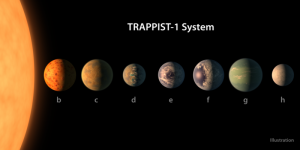 by Kenny Walter – Digital Reporter – @RandDMagazine Wed, 02/22/2017
by Kenny Walter – Digital Reporter – @RandDMagazine Wed, 02/22/2017
Could we be on the verge of discovering life outside of Earth?
On Feb. 22, NASA officials announced the discovery of seven Earth-sized exoplanets that orbit around the ultra-cool dwarf TRAPPIST-1 star, with at least three of the planets showing signs that they may be able to contain liquid water.
Thomas Zurbuchen, associate administrator of the Science Mission Directorate at NASA Headquarters in Washington D.C., said during a press conference that the finding could lead to the discovery of a planet that mimics the conditions on Earth.
“Three of these planets are in the habitable zone, where liquid water could pool on the surface,” Zurbuchen said. “In fact, with the right atmospheric conditions water can form on any of these planets. The discovery gives us a hint that finding a second Earth is not just a matter of if, but when.”
The research team used NASA’s Spitzer Space Telescope to reveal the first known system of seven Earth-sized planets that orbit around a single star.
The system is located about 40 light years from Earth in the constellation Aquarius. The planets are termed ‘exoplanets’ because they are located outside of Earth’s solar system.
According to Zurbuchen, the discovery could help answer the age-old question of whether life exists outside of Earth.
“This is a major step forward towards answering one of the very questions that is at the heart of so many of our philosophers and what we’re thinking about when we are by ourselves and that basically is ‘are we alone out there’,” he said. “This is a leap forward towards answering that question.”
Nikole Lewis, an astronomer at the Space Telescope Science Institute in Baltimore, said the planet that most resembles Earth is TRAPPIST-1 E.
“It is very close in size to Earth and it also receives about the same amount of light that Earth does in our own solar system,” Lewis said. “This means you can have temperatures that are very similar to the ones we have here on Earth.”
Lewis said TRAPPIST-1 F is the most water rich planet and TRAPPIST-1 G is the largest of the planets in the habitable zone.
All seven exoplanets are closer to their host star than Mercury is to the Sun.
According to Michael Gillon, an astronomer at the University of Liege in Belgium, this is the first time they have discovered an Earth-sized planet in a solar system.
Gillon also said that the TRAPPIST-1 is a smaller and ultimately cooler star than the Sun.
Sean Carey, the manager of NASA’s Spitzer Science Center at Caltech/IPAC in Pasadena, described the new system that was observed.
“The TRAPPIST-1 system and its planets have a very interesting configuration,” Carey said during the press conference. “The planets are all very close together and their orbits are spaced such so that they gravitationally interact with each other.
“They tug and pull each other as they go flying around their star,” he added.
Carey said this information can help identity the density of each of these planets.
Sara Seager, a professor of planetary science and physics at the Massachusetts Institute of Technology said the next step will be to use the James Webb Space Telescope to try to determine if water or gas exists on any of these planets.
Lewis also said the astronomers will use the Hubble Space Telescope to determine whether or not the planets contain a hydrogen-helium based atmosphere. If they don’t it would lend more credence to whether the planets could be inhabitable.
http://www.rdmag.com/news/2017/02/nasa-discovers-seven-new-earth-sized-planets-orbiting-one-star?et_cid=5842555&et_rid=82438012&type=cta&et_cid=5842555&et_rid=82438012&linkid=content






